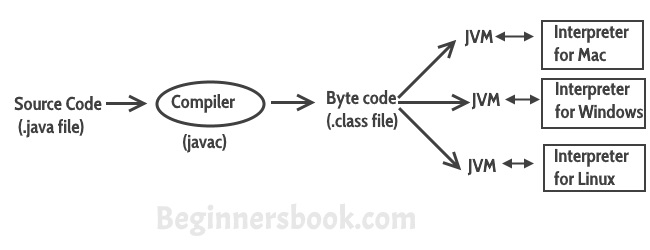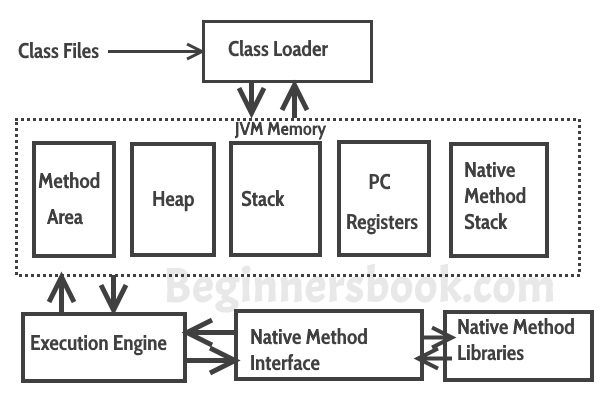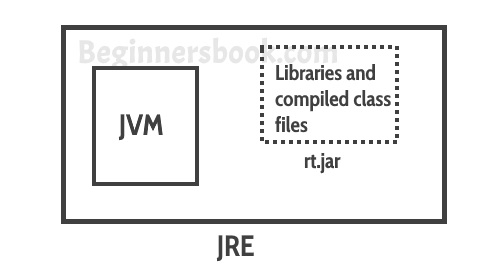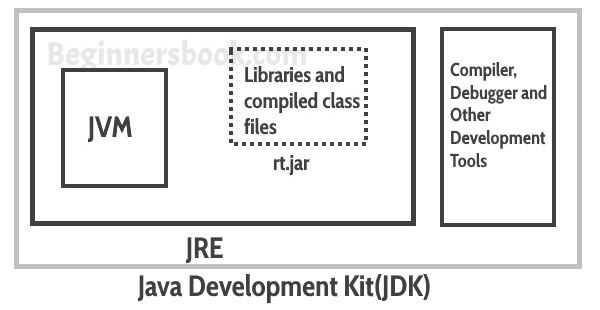Java is a high level programming language. A program written in high level language cannot be run on any machine directly. First, it needs to be translated into that particular machine language. The javac compiler does this thing, it takes java program (.java file containing source code) and translates it into machine code (referred as byte code or .class file).
Java Virtual Machine (JVM) is a virtual machine that resides in the real machine (your computer) and the machine language for JVM is byte code. This makes it easier for compiler as it has to generate byte code for JVM rather than different machine code for each type of machine. JVM executes the byte code generated by compiler and produce output. JVM is the one that makes java platform independent.
So, now we understood that the primary function of JVM is to execute the byte code produced by compiler. Each operating system has different JVM, however the output they produce after execution of byte code is same across all operating systems. Which means that the byte code generated on Windows can be run on Mac OS and vice versa. That is why we call java as platform independent language. The same thing can be seen in the diagram below:


So to summarise everything: The Java Virtual machine (JVM) is the virtual machine that runs on actual machine (your computer) and executes Java byte code. The JVM doesn’t understand Java source code, that’s why we need to have javac compiler that compiles *.java files to obtain *.class files that contain the byte codes understood by the JVM. JVM makes java portable (write once, run anywhere). Each operating system has different JVM, however the output they produce after execution of byte code is same across all operating systems.
JVM Architecture

Lets see how JVM works:
Class Loader: T
1) Classloader
Classloader is a subsystem of JVM which is used to load class files. Whenever we run the java program, it is loaded first by the classloader. There are three built-in classloaders in Java.
- Bootstrap ClassLoader: This is the first classloader which is the super class of Extension classloader. It loads the rt.jar file which contains all class files of Java Standard Edition like java.lang package classes, java.net package classes, java.util package classes, java.io package classes, java.sql package classes etc.
- Extension ClassLoader: This is the child classloader of Bootstrap and parent classloader of System classloader. It loades the jar files located inside $JAVA_HOME/jre/lib/ext directory.
- System/Application ClassLoader: This is the child classloader of Extension classloader. It loads the classfiles from classpath. By default, classpath is set to current directory. You can change the classpath using "-cp" or "-classpath" switch. It is also known as Application classloader.
Method Area: There is only one method area in a JVM which is shared among all the classes. This holds the class level information of each .class file.
Heap: Heap is a part of JVM memory where objects are allocated. JVM creates a Class object for each .class file.
Stack: Stack is a also a part of JVM memory but unlike Heap, it is used for storing temporary variables.
PC Registers: This keeps the track of which instruction has been executed and which one is going to be executed. Since instructions are executed by threads, each thread has a separate PC register.
Native Method stack: A native method can access the runtime data areas of the virtual machine.
Native Method interface: It enables java code to call or be called by native applications. Native applications are programs that are specific to the hardware and OS of a system.
Garbage collection: A class instance is explicitly created by the java code and after use it is automatically destroyed by garbage collection for memory management.
Execution Engine
It contains:
- A virtual processor
- Interpreter: Read bytecode stream then execute the instructions.
- Just-In-Time(JIT) compiler: It is used to improve the performance. JIT compiles parts of the byte code that have similar functionality at the same time, and hence reduces the amount of time needed for compilation. Here, the term "compiler" refers to a translator from the instruction set of a Java virtual machine (JVM) to the instruction set of a specific CPU.
Java Native Interface
Java Native Interface (JNI) is a framework which provides an interface to communicate with another application written in another language like C, C++, Assembly etc. Java uses JNI framework to send output to the Console or interact with OS libraries.
JVM Vs JRE Vs JDK
JRE: JRE is the environment within which the java virtual machine runs. JRE contains Java virtual Machine(JVM), class libraries, and other files excluding development tools such as compiler and debugger.
Which means you can run the code in JRE but you can’t develop and compile the code in JRE.
Which means you can run the code in JRE but you can’t develop and compile the code in JRE.
JVM: As we discussed above, JVM runs the program by using class, libraries and files provided by JRE.

JDK: JDK is a superset of JRE, it contains everything that JRE has along with development tools such as compiler, debugger etc.


JDK: JDK is a superset of JRE, it contains everything that JRE has along with development tools such as compiler, debugger etc.



0 Comments